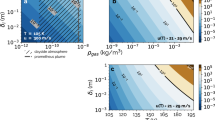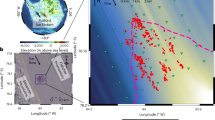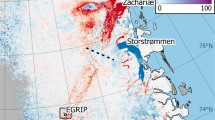Abstract
Long-runout landslides are debris flows or avalanches that travel much farther than expected. They apparently exhibit friction coefficients much lower than either the static or sliding values that are generally accepted for geologic materials. Many friction-reduction mechanisms have been proposed for such landslides observed on Earth and Mars. Here we analyse images from the Cassini mission and report numerous long-runout landslides on Iapetus, an icy satellite of exceptional topographic relief. Its extremely cold, airless surface provides an excellent laboratory for studying long-runout landslides, as influence by trapped atmosphere or groundwater—two proposed friction-reduction mechanisms—is negligible. We use the ratio of drop height to runout length as an approximation for the friction coefficient of landslide material. We find that on Iapetus this ratio falls between 0.1 and 0.3, but does not decrease with increasing length as seen on Earth and Mars. We show that this lack of dependence is consistent with localized frictional heating in ice rubble such that sliding surfaces are slippery. Friction along tectonic faults on icy bodies may be similarly reduced.
This is a preview of subscription content, access via your institution
Access options
Subscribe to this journal
Receive 12 print issues and online access
$259.00 per year
only $21.58 per issue
Buy this article
- Purchase on Springer Link
- Instant access to full article PDF
Prices may be subject to local taxes which are calculated during checkout





Similar content being viewed by others
References
Hsü, K. J. Catastrophic debris streams (sturzstroms) generated by rockfalls. Geol. Soc. Am. Bull. 86, 129–140 (1975).
De Blasio, F. V. Introduction to the Physics of Landslides (Springer, 2011).
Lucchitta, B. K. Landslides in Valles Marineris, Mars. J. Geophys. Res. 84, 8097–8113 (1979).
Lucchitta, B. K. Valles Marineris, Mars—Wet debris flows and ground ice. Icarus 72, 411–429 (1987).
McEwen, A. S. Mobility of large rock avalanches: Evidence from Valles Marineris, Mars. Geology 17, 1111–1114 (1989).
Quantin, C., Allemand, P. & Delacourt, C. Morphology and geometry of Valles Marineris landslides. Planet. Space Sci. 52, 1011–1022 (2004).
Shreve, R. L. Sherman landslide, Alaska. Science 154, 1639–1643 (1966).
Shreve, R. L. The Blackhawk landslide. Spec. Pap. Geol. Soc. Am. 108, 1–47 (1968).
Legros, F. The mobility of long-runout landslides. Eng. Geol. 63, 301–331 (2002).
Johnson, B. in Rockslides and Avalanches, 1, Natural Phenomena (ed. Voight, B.) 481–504 (Elsevier Science, 1978).
Harrison, K. P. & Grimm, R. E. Rheological constraints on martian landslides. Icarus 163, 347–362 (2003).
De Blasio, F. V. Landslides in Valles Marineris (Mars): A possible role of basal lubrication by sub-surface ice. Planet. Space Sci. 59, 1384–1392 (2011).
Erismann, T. H. Mechanisms of large landslides. Rock Mech. 12, 15–46 (1979).
De Blasio, F. V. & Elverhøi, A. A model for frictional melt production beneath large rock avalanches. J. Geophys. Res. 113, F02014 (2008).
Weidinger, J. T. & Korup, O. Frictionite as evidence for a large Late Quaternary rockslide near Kanchenjunga, Sikkim Himalayas, India—Implications for extreme events in mountain relief destruction. Geomorphology 103, 57–65 (2009).
Han, R., Hirose, T., Shimamoto, T., Lee, Y. & Ando, J. Granular nanoparticles lubricate faults during seismic slip. Geology 39, 599–602 (2011).
Davis, T. R. H. Spreading of rock avalanche debris by mechanical fluidization. Rock Mech. Rock Eng. 15, 9–24 (1982).
Campbell, C. S., Cleary, P. W. & Hopkins, M. J. Large-scale landslide simulations: Global deformation, velocities and basal friction. J. Geophys. Res. 100, 8267–8283 (1995).
Melosh, H. J. Acoustic fluidization—A new geologic process? J. Geophys. Res. 84, 7513–7520 (1979).
Melosh, H. J. The physics of very large landslides. Acta Mech. 64, 89–99 (1986).
Collins, G. S. & Melosh, H. J. Acoustic fluidization and the extraordinary mobility of sturzstroms. J. Geophys. Res. 108, 2473–2486 (2003).
Kleinhans, M. G., Markies, H., de Vet, S. J., in’t Veld, A. C. & Postema, F. N. Static and dynamic angles of repose in loose granular materials under reduced gravity. J. Geophys. Res. 116, E11004 (2011).
Lajeunesse, E. et al. New insights on the runout of large landslides in the Valles-Marineris Canyons, Mars. Geophys. Res. Lett. 33, L04403 (2006).
Staron, L. & Lajeunesse, E. Understanding how the volume affects the mobility of dry debris flows. Geophys. Res. Lett. 36, L12402 (2009).
Holsapple, K. A. On the flow and fluidization of granular materials: Applications to large lunar craters, cliff collapses, and asteroid shapes. 42nd Lunar Planet. Sci. Conf. abs. #2612 (2011).
Giese, B. et al. The topography of Iapetus’ leading side. Icarus 193, 359–371 (2008).
Porco, C. C. et al. Cassini imaging science: Initial results on Phoebe and Iapetus. Science 307, 1237–1242 (2005).
Schenk, P. M. AAS/Division for Planetary Sciences Meeting 42 abs. #9.16 (2010).
Singer, K. N. & McKinnon, W. B. Tectonics on Iapetus: Despinning, respinning, or something completely different? Icarus 216, 198–211 (2011).
Spencer, J. R. & Denk, T. Formation of Iapetus’ extreme albedo dichotomy by exogenically triggered thermal ice migration. Science 327, 432–435 (2010).
Schenk, P. M. & Bulmer, M. H. Origin of mountains on Io by thrust faulting and large-scale mass movements. Science 279, 1514–1517 (1998).
Chuang, F. C. & Greeley, R. Large mass movements on Callisto. J. Geophys. Res. 105, 20227–20244 (2000).
Hampton, M. A. & Locat, J. Submarine landslides. Rev. Geophys. 34, 33–59 (1996).
Jaeger, J. C., Cook, N. G. W. & Zimmerman, R. W. Fundamentals of Rock Mechanics Ch. 3 (Wiley–Blackwell, 2007).
Beeman, M., Durham, W. B. & Kirby, S. H. Friction of ice. J. Geophys. Res. 93, 7625–7633 (1988).
Kimura, J. et al. Sublimation’s impact on temporal change of albedo dichotomy on Iapetus. Icarus 214, 596–605 (2011).
Maeno, N. & Arakawa, M. Adhesion shear theory of ice friction at low sliding velocities, combined with ice sintering. J. Appl. Phys. 95, 134–139 (2004).
Kietzig, A-M., Hatzikiriakos, S. G. & Englezos, P. Physics of ice friction. J. Appl. Phys. 107, 081101 (2010).
Di Toro, G. et al. Fault lubrication during earthquakes. Nature 471, 494–498 (2011).
Goldsby, D. L. & Tullis, T. E. Flash heating leads to low frictional strength of crustal rocks at earthquake slip rates. Science 334, 216–218 (2011).
Petrenko, V. F. & Whitworth, R. W. Physics of Ice (Oxford Univ. Press, 1999).
Rosenberg, R. Why is ice slippery? Phys. Today 58, 50–55 (2005).
Dones, L. et al. in Saturn from Cassini-Huygens (eds Dougherty, M. K., Esposito, L. W. & Krimigis, S. M.) 613–635 (Springer, 2009).
Dombard, A. J., Cheng, A. F., McKinnon, W. B. & Kay, J. P. Delayed formation of the equatorial ridge on Iapetus from a sub-satellite created in a giant impact. J. Geophys. Res. 117, 03002 (2012).
Schenk, P. M., Wilson, R. R. & Davies, A. G. Shield volcano topography and the rheology of lava flows on Io. Icarus 169, 98–110 (2004).
Moore, J. M. et al. Mass movement and landform degradation on the icy Galilean satellites: Results of the Galileo nominal mission. Icarus 140, 294–312 (1999).
Acknowledgements
This work was supported by grants from the NASA Planetary Geology and Geophysics Program (W.B.M.) and Cassini Data Analysis Program (J.M.M. and P.M.S.) and by a NESS Fellowship to K.N.S. We sincerely thank A. Lucas for comments that substantially improved this paper, and dedicate this work to the memory of R. Greeley.
Author information
Authors and Affiliations
Contributions
K.N.S. collected the landslide data and along with W.B.M. compiled the literature data and wrote the paper. P.M.S. created and supplied the topography data used here and along with J.M.M. contributed to discussion of the data and revisions to the manuscript.
Corresponding author
Ethics declarations
Competing interests
The authors declare no competing financial interests.
Supplementary information
Supplementary Information
Supplementary Information (PDF 20519 kb)
Rights and permissions
About this article
Cite this article
Singer, K., McKinnon, W., Schenk, P. et al. Massive ice avalanches on Iapetus mobilized by friction reduction during flash heating. Nature Geosci 5, 574–578 (2012). https://doi.org/10.1038/ngeo1526
Received:
Accepted:
Published:
Issue Date:
DOI: https://doi.org/10.1038/ngeo1526
This article is cited by
-
Effect of Vibration On Characteristics of Granular Inclined Chute Flow Under Low-gravity
Microgravity Science and Technology (2023)
-
Power density-dependent friction weakening for long-runout landslides and its revelation of volume and topographical effects
Acta Geotechnica (2023)
-
Influence of bottom roughness and ambient pressure conditions on the emplacement of experimental dam-break granular flows
Granular Matter (2021)
-
Longitudinal ridges imparted by high-speed granular flow mechanisms in martian landslides
Nature Communications (2019)
-
Geomorphological evidence for ground ice on dwarf planet Ceres
Nature Geoscience (2017)



